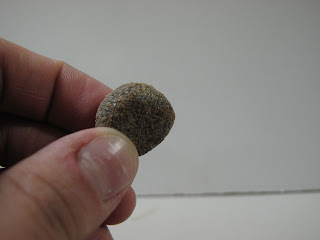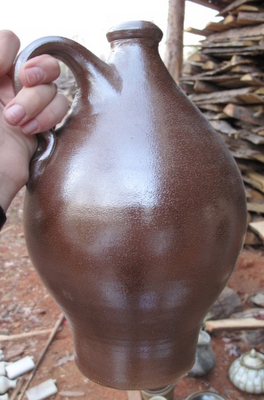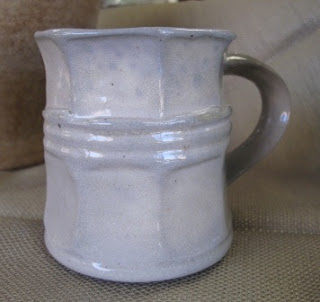 |
| A box of kiln wadding. Courtesy, National Park Service, Colonial National Historical Park, Yorktown Collection |
Next time you go to wad your pottery for a kiln firing, think of the William Rogers pottery factory in Yorktown, Virginia. William Rogers was the proprietor of the pottery, which operated from the 1720s until circa 1745. William Rogers is often referred to as the "Poor Potter" of Yorktown. This was due to a 1732
report written by Governor Gooch of Virginia which said "
As to manufactures seet up, there is one poor Potters work for course earthen ware, which is of so little consequence, that I dare say there hath not been twenty shillings worth less of that comodity imported since it was sett up than there was before." This report was not exactly telling the truth, and in fact, William Rogers' production was quite lucrative, reportedly selling as far as New England (see the 2004
Ceramics In America publication for two good articles on Rogers). This site produced both earthenware and stoneware vessels. I had the pleasure last week of looking over the kiln furniture and some of the archaeological material from the stoneware kiln site. One of the most fascinating things to me was to handle the wadding and props from the kiln.
 |
| Courtesy, National Park Service, Colonial National Historical Park, Yorktown Collection |
For those who do not crouch in, stand next to, or crawl around in kilns loading pots, wadding is a basic component which (in modern recipes) usually consists of kaolin, alumina hydrate, and sometimes grog, or heavy sand.
 |
| You can see the texture of the sand on this small piece of wadding. Courtesy, National Park Service, Colonial National Historical Park, Yorktown Collection |
Historically, it would seem that many potters used their basic clay combined with grog. Wadding basically acts as a buffer between the pot which it is put underneath and the other vessels or kiln furniture. It basically keeps the pot from sticking to everything. Very handy in a salt-glaze kiln, which the William Rogers site was. And, historically, kiln shelves were generally not used, so pieces were often stacked one on top of the other.
 |
| This is the base of a tankard. You can see the small orange-colored spots which are where the wadding was placed on the tankard before it was fired. Wadding typically leaves little marks like this. Courtesy, National Park Service, Colonial National Historical Park, Yorktown Collection |
 |
| This is the interior floor of a saggar. You can see the orange-colored markings where there were vessels propped up. My estimation is that this saggar held mugs with three pieces of wadding on each mug. Count up the little marks and you can kind of guess where the mugs were sitting! Courtesy, National Park Service, Colonial National Historical Park, Yorktown Collection |
Wadding usually has no particular shape, and is often just grabbed and made into whatever shape is necessary for the vessel, be it a small ball, a square pad, or a fistful. There were quite a few fistfulls in the collection, which was really fun to hold and see the fingerprints of the potters.
 |
| A fistful of wadding with my fingers in the same place as the original potter. Courtesy, National Park Service, Colonial National Historical Park, Yorktown Collection |
There were some pieces of wadding which I thought may have been used in a particular way, and connected to some of the archaeological vessels I looked at. Take a look at this bottle, and notice the marks on the shoulder of the bottle where my fingers are.
 |
| Courtesy, National Park Service, Colonial National Historical Park, Yorktown Collection |
 |
| Courtesy, National Park Service, Colonial National Historical Park, Yorktown Collection |
 |
| Courtesy, National Park Service, Colonial National Historical Park, Yorktown Collection |
There were likely wads or pads there, and this may have been the shape of the wadding:
 |
| Courtesy, National Park Service, Colonial National Historical Park, Yorktown Collection |
I say that because if you think about sitting something on the shoulder of the bottle, a triangular piece of wadding would work really well for support. I could be wrong here, I'll have to test my theory once I get a kiln built!
Happy wadding.


















